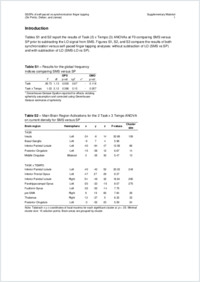Steady-state evoked potentials distinguish brain mechanisms of self-paced versus synchronization finger tapping
- De Pretto, Michael Faculty of Psychology and Educational Sciences, Department of Psychology, University of Geneva, Switzerland - Neurology Unit, Medicine Department, Faculty of Sciences, University of Fribourg, Switzerland - School of Philosophy, Psychology and Language Sciences, Department of Psychology, University of Edinburgh, UK
- Deiber, Marie-Pierre Faculty of Psychology and Educational Sciences, Department of Psychology, University of Geneva, Switzerland - NCCR Synapsy, Geneva, Switzerland
- James, Clara E. Faculty of Psychology and Educational Sciences, Department of Psychology, University of Geneva, Switzerland - School of Health Sciences Geneva, HES-SO University of Applied Sciences and Arts Western Switzerland, Geneva, Switzerland
-
01.10.2018
Published in:
- Human Movement Science. - 2018, vol. 61, p. 151–166
English
Sensorimotor synchronization (SMS) requires aligning motor actions to external events and represents a core part of both musical and dance performances. In the current study, to isolate the brain mechanisms involved in synchronizing finger tapping with a musical beat, we compared SMS to pure self-paced finger tapping and listen- only conditions at different tempi. We analyzed EEG data using frequency domain steady-state evoked potentials (SSEPs) to identify sustained electrophysiological brain activity during repetitive tasks. Behavioral results revealed different timing modes between SMS and self-paced finger tapping, associated with distinct scalp topographies, thus suggesting different underlying brain sources. After subtraction of the listen-only brain activity, SMS was compared to self-paced finger tapping. Resulting source estimations showed stronger activation of the left inferior frontal gyrus during SMS, and stronger activation of the bilateral inferior parietal lobule during self-paced finger tapping. These results point to the left inferior frontal gyrus as a pivot for perception–action coupling. We discuss our findings in the context of the ongoing debate about SSEPs interpretation given the variety of brain events contributing to SSEPs and similar EEG frequency responses.
- Faculty
- Faculté des sciences et de médecine
- Department
- Médecine 3ème année
- Language
-
- English
- Classification
- Biological sciences
- License
-
License undefined
- Identifiers
-
- RERO DOC 323454
- DOI 10.1016/j.humov.2018.07.007
- Persistent URL
- https://folia.unifr.ch/unifr/documents/307379
Other files
Statistics
Document views: 127
File downloads:
- pdf: 223
- Supplementary material: 156

